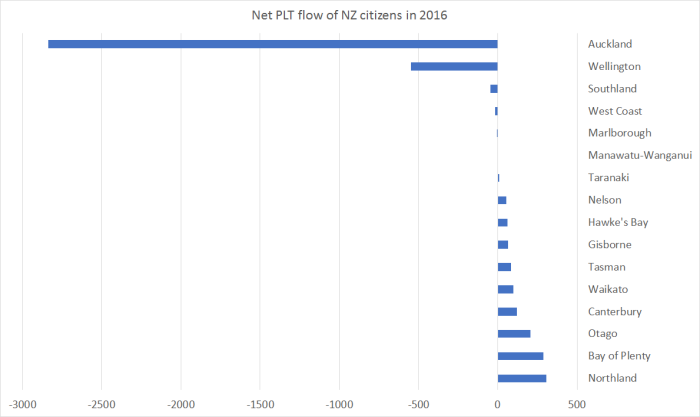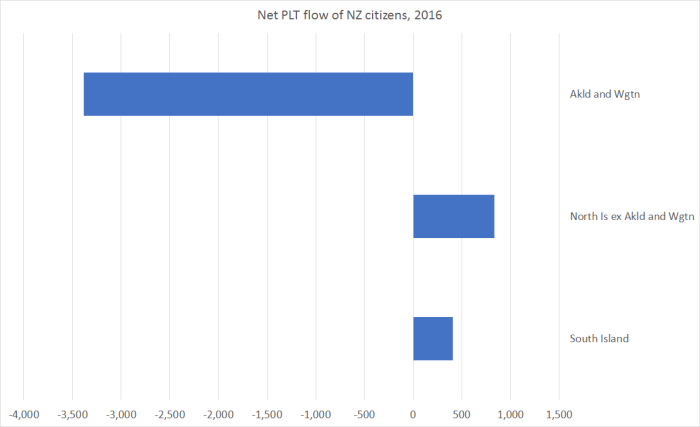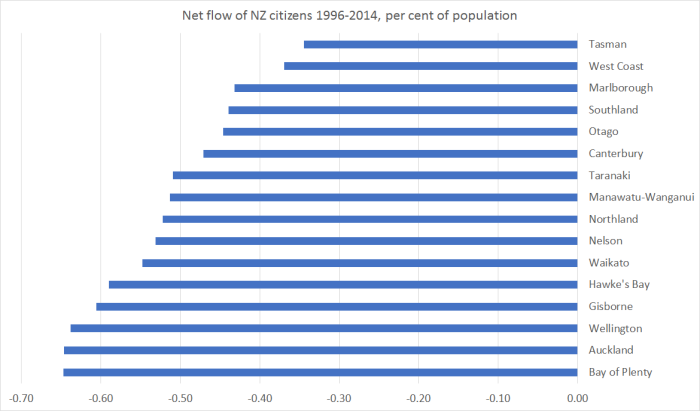Having not lived anywhere else in New Zealand since I was 10, I’m not quite sure.
Yesterday I was filming an interview in which one of the questions the interviewer asked was whether Auckland house prices could be explained, at least in part, by an influx of New Zealanders, whether returning from overseas or moving to Auckland from elsewhere in New Zealand. I noted that the data actually still showed a net outflow of New Zealanders from Auckland to other countries in 2016 (albeit much smaller than in earlier years), and that Census data had suggested a modest net outflow of Aucklanders to the rest of New Zealand since the mid 1990s, and that that pattern seemed unlikely to have changed in the years since the last census.
All of which got me curious. If New Zealanders were still (net) leaving Auckland for abroad, what was happening in other regions of the country. Were there places where there was a net inflow of returning New Zealanders? As it happened, the answer proved to be most of them.

Auckland and Wellington were, in fact, the outliers.
Here is a more aggregated look at the same data.

New Zealanders (net) came back last year to the rest of the North Island, and to the South Island, but not to Auckland or Wellington.
I wouldn’t want to make too much of it. It is, after all, one year’s data, and has all the pitfalls of the PLT data (self-reported intentions and all that).
But it did bring to mind some analysis from The Treasury that I highlighted a couple of weeks ago
As agglomeration and clustering theory predicts, our more urban services-based regional economies (Auckland and Wellington and to a lesser extent Christchurch) are relatively more productive and generate higher incomes than our more resource-based regional economies.
Our Treasury preference is usually to encourage or permit the continued concentration of economic activity in key centres (forces of agglomeration) where returns are expected to be greatest. Resources and activities should be allowed to flow betwen regions over time.
New Zealanders don’t seem to have been convinced by our officials’ analysis of the prospects and opportunities within New Zealand.
What about over a longer period? Here is the average annual net outflow of New Zealand citizens from each regional council area, as a per cent of that region’s population each year, for the period 1996 to 2014 (ie from when the data start to just prior to the current sharp reduction in the overall outflow of New Zealanders).

Wellington and Auckland were losing just over 0.6 per cent of their population each year as New Zealand citizens left those regions for abroad. But so were the Bay of Plenty and Gisborne. (What is, perhaps, more striking is how much lower the net outflow rate abroad was from the South Island). And in the last year, New Zealanders flowed into Gisborne and the Bay of Plenty, and they still flowed out of Wellington and Auckland.
I can think of various stories why this might be. Auckland, presumably, has the highest share of naturalised citizens, and perhaps there is more of tendency for those new citizens to leave, than for natives? But if so, it doesn’t explain the previous 20 years of Wellington, Bay of Plenty or Gisborne. And while house prices are ruinously high in Auckland, they are nowhere near so bad in Wellington. Perhaps there is something in a story about Auckland and Wellington people being more “internationally connected” – but again, over almost 20 years, the outflow rates were the same in the Bay of Plenty and Gisborne. And perhaps, for all the talk of agglomeration opportunities, and a focus on Auckland and Wellington, the economic opportunities, and overall prospective living standards, just aren’t really there in Auckland and Wellington. The regional per capita GDP data certainly support that story for Auckland.
Perhaps the patterns will change again this year – and there is quite a bit of year-to-year variation in the regional outflow rates – but for now, despite all the talk of “problems of success“, or “quality problems“, the migration data suggest New Zealanders when deciding whether to stay or go, and where to come back to if they do, don’t seem to share the sense of Wellington and Auckland as success stories.
Other interpretations/perspectives most welcome.
“Auckland, presumably, has the highest share of naturalised citizens, and perhaps there is more of tendency for those new citizens to leave, than for natives? But if so, it doesn’t explain the previous 20 years”
Where are you getting the data from?
Does the data you are using allow for the probability that many departing naturalised citizens arrived during the past 20 years as a NON-national on a NON-New Zealand Passport, applied for citizenship, obtained it, applied for a NZ passport, obtained it, and then departed as an NZ’er on a NZ passport
Arrived as one identity and departed as another
Remember Australia changed its entry rules for NZers because NZ was being used as a back-door entry into Australia
LikeLiked by 1 person
THey are SNZ PLT data from Infoshare. Yes, the suggestion you are making is exactly the one I was alluding to with the point about a greater proportion of naturalised citizens in Akld than in most of the rest of NZ.
LikeLike
In the 2011 Australian Census, the top ancestry responses* that New Zealand-born people reported were English (222 956), New Zealander (86 724), Scottish (83 156) and Maori (82 577).
The main languages spoken at home by New Zealand-born people in Australia were English (440 649), Samoan (11 931) and Maori (New Zealand) (8067).
https://wayback.archive.org/web/20140212131237/http://www.immi.gov.au/media/publications/statistics/comm-summ/textversion/newzealand.htm
LikeLike
According to 2011 Australian Census data, there are 128,434 Maori living in Australia – affectonately nicknamed “Mozzies”.
http://www.sbs.com.au/news/article/2014/03/21/maori-australian-dream-all-its-cracked-be
LikeLike
Another possibility
Any Aucklander who in the past 10 years sold up and emmigrated to Australia, settled there, bought property there, then decided to relocate back to NZ will find they cannot re-establish themselves back into Auckland into a home equivalent to what they left 10 years before
They have little choice but to look elsewhere
LikeLike
Micheal..We still live in the same property in Ellerslie Auckland.1920’s bungalow on 1012m2 of nearly flat land nearly at the top of the hill,faces west.Purchase price 1981…..$59,000 .Ellerslie Borough Coucil.Zoned Residential for 4 dwellings.
By 1993…Auckland City Council had swollowed the EBC in 1989, the RMAct came along 1991,new ACC district plan 1993.We were now a 2 dwelling site.Market value ( I am still a LREAA.) 1993 $250,000.
We have not had that growth in values in the last 10 years.
So what were the drivers?
1. Basel 1.1986
2 .RMA/.1991
3. ACC nimby zoning.1993
Edgar Henson
021763900
LikeLike
Current valuation on homes.co.nz is $1.7 million. The Unitary Plan zoning is mixed housing suburban.
LikeLike
Auckland’s population
1981 – 770k people Value $59k
1993 – 1million people Value $250k
2016 – 1.5 million people Value $1.7m
It seems to me that population growth would mean that land values is the most expensive closer to the central CBD core. The Nimby effect does not equate to more expensive houses. The Nimby effect prevents higher density on expensive land to lower the average value. The underlying land remains expensive but higher density allows the average price of property to fall by increasing the number of units on that 1012sqm.
Usually the single house suburbs should be in the fringe with an expensive central core. But in the effort to preserve the visual height limits of 57 sacred mounts, Auckland council has moved Aucklands 18 level high rise metropolitan cities to the fringe which creates expensive land from the central core right up to the fringe.
LikeLike
BOP & Gisbourne had many working men who drove diggers and trucks for forestry.
when things went sad they all left for Aussie. When things improved they have mostly returned. The housing market in Rotorua and Gisbourne reflect that.
Rotorua was a very hard rental market for about 5 years and now has not enough rentals and rents have doubled.
Tga was similar but recovered sooner.
LikeLike
I would -be more inclined to point towards the booming 3.5 million tourists overflowing into residential property driving this shortage of rentals.
LikeLike
Tourism accounts for accommodation shortages for sure but not rental house shortages. Incoming Tourists require about 10000 beds per night. Some of course will be aboard ships and the rest mostly tourist accommodation including camper vans.
Internal tourism adds to this and this would be where most tourist demands for accommodation come from via book a batch, Airbnb and so on.
LikeLike
Yes indeed, rental house accomodation. Houses can rent for $350 a night with95% occupancy which makes it more attractive than weekly renters. Boils down to the lack of motels nd hotels being built to accomodate the rising numbers of tourists.
LikeLike
Maybe some of this is people retiring out of metropolitan New Zealand to non-metropolitan New Zealand. Including expat New Zealanders who have come back to settle down, potter in the garden, play bowls, or whatever old people do.
LikeLiked by 1 person
There was a huge outflow of young tradespeople from places like gisborne in about 2004-2008. Most of my friends from school went over to Perth in particular, working fifo all over WA. Since then, the work has dried up somewhat, sending a few home, but also, those young tradespeople are now in their early thirties and now have partners and young kids. Fly-in-fly-out is pretty destructive on the family life, so most are selling up whatever they didn’t manage to drink away and coming back to particularly gisborne, Rotorua and Tauranga for a cruisier lifestyle. Most of them are stepping straight into mechanical roles supporting the forestry boom in those areas. So, it as much a sign of life stage as it is economics.
LikeLiked by 1 person